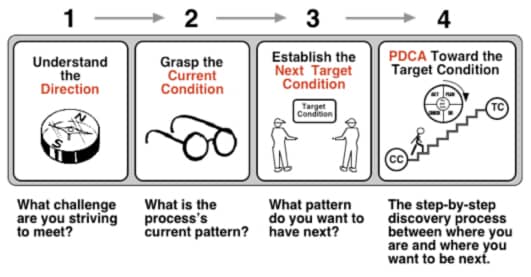How to run your first improvement kata
The improvement kata can solve problems that typical retrospectives fail to address. Although there is a halo of mystery around it, it’s actually not that difficult to get started ! Here is a guide.
During the last few weeks, I’ve been blogging about the improvement kata. You can read the full story of the first time we applied it in our team to gain 25% of productivity. If you are more interested by what it taught us, check this other post.

A 5 bullets summary
Here is how I would explain what the improvement kata is :
- It’s a continuous improvement technique. It relies on the scientific method to reach a target state.
- It involves running experiments to know if your ideas are valid.
- It can be long to run through, but it works on tricky situation where retrospectives don’t.
- It’s 100% scientific. It uses data analysis and deduction. Not gut feeling and community best practices.
- It can be part of the backlog, as any other item. It does not have to be a special event like retrospectives usually are.

💡 The improvement kata is 100% scientific, it uses data and deduction, not gut feeling and best practices
Let’s give it a try !
Is that enough for you to give it a try ? If so, great, read on ! If you need a bit more convincing, check the full story of how we gained 25% of productivity with it.
Here is how to get started :
- The first thing is to read about it. If you have the time, Toyota Kata is a good read. If you read French, the “Petit guide de management lean à l’usage des équipes agiles” is a very pleasant and easy read. Finally if you want to cut it as short as possible, read the Toyota Kata website.
- Pick a topic to try it on. Best candidates are clear and important problems. They might have emerged out of a retrospective for example. The scope should be small enough not to get lost.
- Once you’ve identified a topic, someone or a pair should take ownership of the kata. It’s very unlikely that you’ll be able to do the full kata in one afternoon. Understanding happens when the brain is at rest, and experiments take time. The owners need to dedicate some time to follow up on the kata.
-
Repeatedly ask yourself the coaching kata questions. This will help you and your pair to stay on track.
- What’s the target condition ? (Describe what are you trying to achieve)
- What’s the actual condition ? (Describe your current situation)
- What obstacles do you think are preventing you from reaching the target condition ? Which one are you addressing now ? (Describe the first problem you are about to try to fix)
- What is your next step ? What do you expect ? (Describe the experiment you are going to run to test a solution)
- When can we go and see what we have learned from taking that step ? (Run the experiment and learn from the results. Decide on a process change or repeat from an earlier step)
- Going through the kata in pair is a great way to spread the practice within the team. At some point you might be able to run many improvement katas in parallel ! Just make sure not to walk on each other’s toes …
Expect the first time to be a bit rocky, and to feel lost from time to time …
Start today !

Many practices and techniques seem daunting at first. Remember the first time you wrote a test before the code. The first time you tried to program using only immutable data structures. Or the time you wrote your first “hello world” program !
💡 We can learn anything on our own by just doing it
The improvement kata is no different. Give it a go, and you’ll learn a powerful technique.
Whether you have already used the kata, you plan to use it or you have questions about it, I’d like to hear from you ! Leave a comment.




Leave a comment